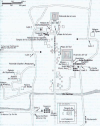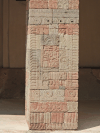
Site map from MexConnect (36k)
Teotihuacán holds the remnants of one of the many Ancient Civilizations that I visited during my travels.
From the Teotihuacán entry in Wikipedia:
Teotihuacán is an ancient Mesoamerican city located in a sub-valley of the Valley of México, which is located in the State of México, 40 km (25 miles) northeast of modern-day México City. Teotihuacán is known today as the site of many of the most architecturally significant Mesoamerican pyramids built in the pre-Columbian Americas.It is the most important and largest pre-Columbian city in México. Teotihuacán is the isoform of Nahuatl Teotihuacán (Teotioyakan), but recently in Spanish has often been replaced by the original word Nahuatl Teotihuacán (Teotioyakan). At its zenith, perhaps in the first half of the first millennium CE, Teotihuacán was the largest city in the pre-Columbian Americas, with a population estimated at 125,000 or more, making it at least the sixth-largest city in the world during its epoch. After the collapse of Teotihuacán, central México was dominated by the Toltecs of Tula until about 1150 CE.

Site map from MexConnect (36k)
The Pre-Hispanic City of Teotihuacán is a UNESCO World Heritage Site.
All pictures are © Dr. Günther Eichhorn, unless otherwise noted.








From the Temple of the Feathered Serpent in Wikipedia:
The Temple of the Feathered Serpent is the third largest pyramid at Teotihuacán. This structure is notable partly due to the discovery in the 1980s of more than a hundred possibly sacrificial victims found buried beneath the structure. The burials, like the structure, are dated to between 150 and 200 CE. The pyramid takes its name from representations of the Mesoamerican "Feathered Serpent" deity which covered its sides. These are some of the earliest-known representations of the Feathered Serpent, often identified with the much-later Aztec god Quetzalcoatl.













From the Quetzalpapálotl in Wikipedia:
The Quetzalpapálotl complex are ruins located in Teotihuacán. The complex is best known for the Palace of Quetzalpapálotl and the stone reliefs in its courtyard. Adjacent structures house surviving murals. The main entrance faces the Avenue of the Dead and is southwest of the Pyramid of the Moon.
The existing structures were built around 450 to 500 CE. These buildings were built over earlier structures from around 250 to 300 CE. Due to the location of the palace and the quality of its art, it is thought the complex was home to a high ranking priest or other dignitary. The complex may have also been used for ceremonial purposes. The name Quetzalpapálotl comes from the reliefs of mythological birds on the courtyard pillars and is from Nahuatl quetzalli, precious feather, and pāpālōtl, butterfly.






From the Pyramid of the Moon in Wikipedia:
The Pyramid of the Moon is the second largest pyramid in modern-day San Juan Teotihuacán, México, after the Pyramid of the Sun. It is 45 m (148 ft) high. It is located in the western part of the ancient city of Teotihuacán and mimics the contours of the mountain Cerro Gordo, just north of the site. Cerro Gordo may have been called Tenan, which in Nahuatl, means "mother or protective stone." The Pyramid of the Moon covers a structure older than the Pyramid of the Sun which existed prior to 200 CE.
The Pyramid's construction between 100 and 450 CE completed the bilateral symmetry of the temple complex. The pyramid is located at the end of the Avenue of the Dead, connected by a staircase, and was used as a stage for performing ritual sacrifices of animals and humans upon. It was also a burial ground for sacrificial victims. These burials were done in order to legitimize the addition of another pyramid layer over the existing one. The passing of several rulers, and rapid changes in ideologies, led to the Pyramid of the Moon\.s exponential expansion between 250 and 400 CE. A platform atop the pyramid was used to conduct ceremonies in honor of the Great Goddess of Teotihuacán, the goddess of water, fertility, the earth, and even creation itself. This platform and the sculpture found at the pyramid's bottom are thus dedicated to The Great Goddess.







From the Pyramid of the Sun in Wikipedia:
The Pyramid of the Sun is the largest building in Teotihuacán, believed to have been constructed about 200 CE, and one of the largest in Mesoamerica. Found along the Avenue of the Dead, in between the Pyramid of the Moon and the Ciudadela, and in the shadow of the massive mountain Cerro Gordo, the pyramid is part of a large complex in the heart of the city.
The name Pyramid of the Sun comes from the Aztecs, who visited the city of Teotihuacán centuries after it was abandoned; the name given to the pyramid by the Teotihuacanos is unknown. It was constructed in two phases. The first construction stage, around 100 CE, brought the pyramid to nearly the size it is today. The second round of construction resulted in its completed size of 225 m (738 ft) across and 75 m (246 ft) high, making it the third largest pyramid in the world, though still just over half the height of the Great Pyramid of Giza (146 m (479 ft)). The second phase also saw the construction of an altar atop of the pyramid which has not survived into modern times.




This page contains 39 pictures
Page last updated on Tue Nov 2 15:50:11 2021 (Mountain Standard Time)
Teotihuacán on guenther-eichhorn.com